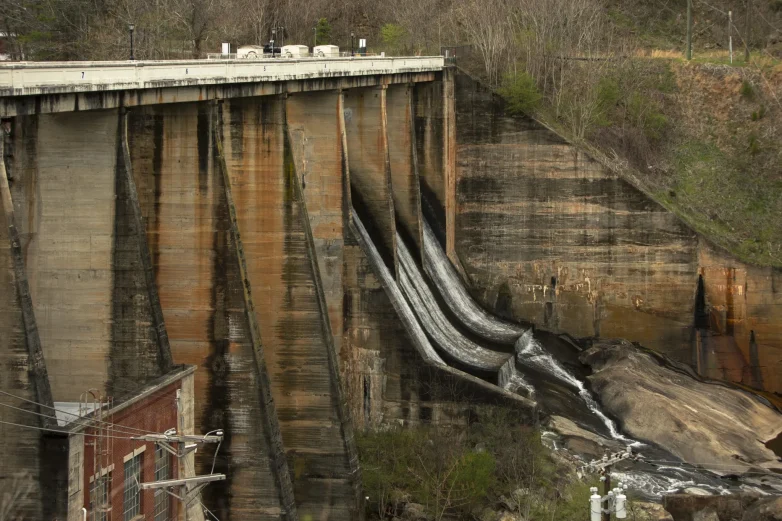To conclude its ARPA reporting project, CPP looks into how other ARPA funds, the $5.4 billion distributed directly to the state, is being spent.
by Shelby Harris November 23, 2022
Carolina Public Press
The Lake Lure dam on March 24. Lake Lure received $200,000 in American Rescue Plan Act funding from the state to conduct an assessment of their sewer system, located beneath the Western North Carolina lake. Photo: Colby Rabon / Carolina Public Press
The federal government distributed North Carolina’s American Rescue Plan Act funds in two ways — $3.2 billion to county and city governments, and $5.4 billion to the state government.
Carolina Public Press spent the past year looking into how ARPA funds are being used by Western North Carolina’s local governments.
To conclude the project, CPP looked into how the other funds, the $5.4 billion distributed directly to the state, is being spent.
The governor’s plan
ARPA, a multitrillion-dollar piece of federal legislation signed into law in March 2021, provides relief funds to state, local and tribal governments that have been negatively impacted by the coronavirus pandemic, “delivering immediate and direct relief to families and workers impacted by the COVID-19 crisis,” according to the U.S. Department of the Treasury.
Governments can use ARPA funds for specific purposes, including addressing public health concerns, replacing lost revenue, expanding broadband and providing premium pay.
County commissioners and city council members throughout the state made spending decisions for the $3.2 million in ARPA funding distributed to local governments. Those decisions varied from fixing sewer systems to bolstering local farmers markets.
For the state’s $5.4 billion ARPA allotment, the N.C. General Assembly made the spending decision, including Gov. Roy Cooper’s ARPA recommendation in the state’s fiscal budget approved in November 2021.
In the recommendation, Cooper wrote that the state’s ARPA allocation should be used for “assisting those families most impacted by the pandemic, upgrading our infrastructure, preparing our workforce, promoting business development and innovation and positioning government to best serve our people.”
Investing in infrastructure
More than half of North Carolina’s ARPA funds have been earmarked to improve the state’s infrastructure, or systems and facilities that maintain the community and economy.
To date, the state has allocated about $2.9 billion (of the $5.4 billion) in ARPA funds toward addressing infrastructure deficits, according to the N.C. Pandemic Recovery Office. Of that amount, about $1.8 billion is reserved for water system improvements, such as repairs to wastewater treatment facilities.
“It’s the category of spending that will probably have the longest sale,” said Lee Lilley, director of the pandemic recovery at the Office of Governor Roy Cooper.
“Built infrastructure takes a little while to do, but it’s really transformative for a lot of places,” Lilley said.
The state is using ARPA to fund N.C. Department of Environmental Quality grants that local governments and nonprofit organizations can apply to get funding for public water system projects.
The projects, many of which will take place on the coast, will update aging infrastructure to ensure clean drinking water for nearby residents.
“Spending money on water and sewer, I mean, that’s foundational for businesses to be able to make investments and to be able to grow. It’s foundational for communities to be able to increase their housing stock,” said Scott Mooneyham from the N.C. League of Municipalities, which advised local governments through ARPA allocations.
Other state ARPA-funded programs include the $48 million Rural Transformation Grant, which provided rural communities funding to enhance communities, revitalize downtowns and strengthen neighborhoods.
ARPA Funding
Broadband in “every corner of the state”
In addition to water system improvements, the state’s other large investment into infrastructure is through its broadband expansion initiative, to which the N.C. General Assembly allocated $660 million in ARPA funding.
Expanding internet access in North Carolina rose in importance during the COVID-19 pandemic, NCDIT Secretary for Broadband and Digital Equity Nate Denny said.
“The pandemic drove home how urgent access to a high-speed internet connection is to every part of modern life: the ability to work from home, learn from home, complete homework, access telemedicine services, apply for jobs or access government services,” Denny said.
Most of North Carolina’s ARPA money for broadband expansion has been used to bolster N.C. Department of Information Technology grants, specifically the Growing Rural Economies with Access to Technology grant and the Completing Access to Broadband program.
Through these programs, the state uses its ARPA money to match funds that local governments or internet providers pledge to broadband infrastructure projects.
In total, $750 million of the state’s ARPA funds will go toward the GREAT grant and CAB program, according to the state budget.
“Our goal here is to ultimately connect every corner of the state to high speed internet,” Lilley said.
According to the governor’s office, broadband infrastructure projects funded through the GREAT grant will provide high-speed internet access to 487,000 households and businesses in North Carolina.
Helping small business
The second-largest portion of North Carolina’s ARPA funds — $666 million — has been disbursed to businesses and organizations, spanning from public libraries to museums.
Get more of our statewide news with impact.
Sign up to receive our free weekday news bulletin and for in-depth, investigative news content about public interest issues in North Carolina.
Within this spending category, more than $500 million in ARPA funding has been earmarked for the Business Recovery Grant, for which small businesses that suffered an economic loss of at least 20% can apply.
More than 7,000 businesses have received funding through the program, according to the governor.
The state’s remaining $1.9 billion is appropriated toward COVID-19 research, premium pay for public school teachers, housing assistance and more.
Challenges with ARPA
Despite billions of ARPA dollars allocated to address the negative effects of the COVID-19 pandemic, many of the issues persist.
An estimated 4 million North Carolina residents lack reliable internet access, and $16.72 billion worth of water infrastructure projects is needed statewide over the next 20 years, according to the U.S. Department of Environment Protection Agency.
“Even with the significant funding we received through ARPA and other funding sources through the pandemic, is it able to solve all the challenges local governments and communities have? Absolutely not. The scale of those challenges are far greater than the funding available,” said Nathan Ramsey from Land of Sky Regional Council, which assisted Western North Carolina’s local governments in ARPA allocation.
All ARPA funds must be allocated by 2024, a deadline the state made with ARPA’s inclusion in the state budget. Any business or organization receiving the funding must spend it by December 2026.
Key milestones for the American Rescue Plan Act from 2021 to 2026. Credit: North Carolina Association of County Commissioners



